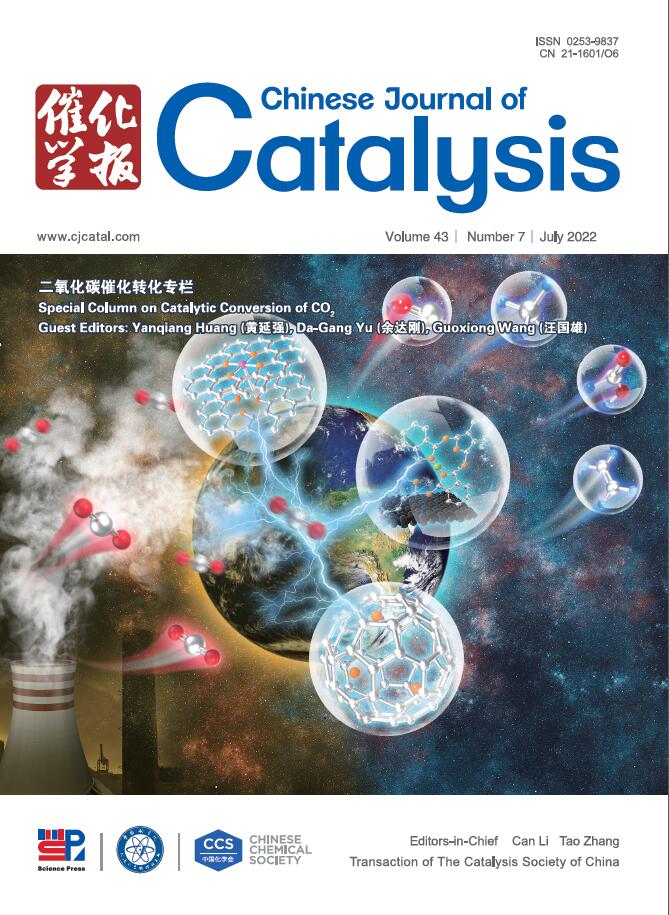Catalytic conversion of biomass waste to methane without external hydrogen source
IF 15.7
1区 化学
Q1 CHEMISTRY, APPLIED
引用次数: 0
Abstract
Methane, the primary constituent of natural gas, shale gas, and flammable ice, serves as a crucial carbon-based energy source and chemical feedstock. Traditional gas reserves are universally acknowledged as limited and non-renewable resources over an extended timespan stretching from decades to millennia. Biomethane, with its unique renewable properties, showcases remarkable development potential and presents a compelling supplement and even alternative for fossil fuel. Although catalytic hydrothermal processes appear as promising valorization routes to transfer biomass to sustainable methane, the safety and supply source of high-pressure hydrogen remain key factors restricting the widespread application. Herein, a catalytic approach without an external hydrogen source was developed to transform waste biomass resources into CH4 under the Ni-Mo catalyst. The total carbon yield of gas products reached up to 92.2%, of which the yield of methane and C2–C4 hydrocarbons were 44.9% and 3.0%, respectively. And it's calculated that approximately 343.6 liters of CH4 could potentially be generated from 1 kilogram of raw biomass. Ni-based catalysts exhibited the robust activity in cleaving C–C and C–O bonds. And the introduction of an appropriate amount of molybdenum significantly enhanced catalytic performance of reforming and subsequent methanation reaction, likely due to the high adsorption capacity of highly dispersed Ni-Mo catalysts for carbon monoxide and hydrogen molecules, facilitating the methanation reaction. The pathway of catalytic methane production might be inferred that CO, H2 and a large number of oxygen-containing intermediates were formed via decarbonylation, dehydrogenation, and retro-aldol condensation reaction under hydrothermal condition. These intermediates then underwent the reforming reaction to generate H2 and CO2, ultimately forming CH4 through the methanation reaction.
无外部氢源的生物质废弃物催化转化为甲烷
甲烷是天然气、页岩气和可燃冰的主要成分,是一种重要的碳基能源和化学原料。从几十年到几千年的时间跨度来看,传统天然气储量被普遍认为是有限的、不可再生的资源。生物甲烷以其独特的可再生特性,显示出巨大的发展潜力,是化石燃料的有力补充,甚至是替代品。虽然催化水热过程是将生物质转化为可持续甲烷的有希望的增值途径,但高压氢的安全性和供应来源仍然是制约其广泛应用的关键因素。本研究开发了一种在Ni-Mo催化剂作用下,将废弃生物质资源转化为CH4的无外部氢源催化方法。气产物总碳收率达92.2%,其中甲烷和C2-C4烃的产率分别为44.9%和3.0%。据计算,大约343.6升CH4可以从1公斤的原始生物质中产生。镍基催化剂对C-C键和C-O键具有较强的裂解活性。适量钼的加入显著增强了重整反应和随后的甲烷化反应的催化性能,这可能是由于高度分散的Ni-Mo催化剂对一氧化碳和氢分子具有较高的吸附能力,有利于甲烷化反应的进行。催化产甲烷的途径可以推断为在水热条件下通过脱羰、脱氢和反醛缩反应生成CO、H2和大量含氧中间体。然后这些中间体进行重整反应生成H2和CO2,最终通过甲烷化反应生成CH4。
本文章由计算机程序翻译,如有差异,请以英文原文为准。
求助全文
约1分钟内获得全文
求助全文
来源期刊

Chinese Journal of Catalysis
工程技术-工程:化工
CiteScore
25.80
自引率
10.30%
发文量
235
审稿时长
1.2 months
期刊介绍:
The journal covers a broad scope, encompassing new trends in catalysis for applications in energy production, environmental protection, and the preparation of materials, petroleum chemicals, and fine chemicals. It explores the scientific foundation for preparing and activating catalysts of commercial interest, emphasizing representative models.The focus includes spectroscopic methods for structural characterization, especially in situ techniques, as well as new theoretical methods with practical impact in catalysis and catalytic reactions.The journal delves into the relationship between homogeneous and heterogeneous catalysis and includes theoretical studies on the structure and reactivity of catalysts.Additionally, contributions on photocatalysis, biocatalysis, surface science, and catalysis-related chemical kinetics are welcomed.
 求助内容:
求助内容: 应助结果提醒方式:
应助结果提醒方式:


